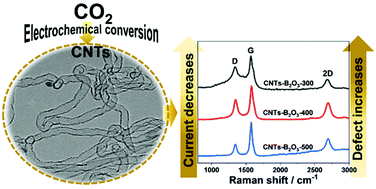Electrochemically controlled in situ conversion of CO2 to defective carbon nanotubes for enhanced H2O2 production†
Abstract
Defects on carbon nanotubes (CNTs) can be used as active sites to promote the occurrence of catalytic reactions and improve the ability of catalysts. Although some progress has been made in the synthesis of defects on carbon nanotubes (CNTs), most of the defects are caused by acid etching or high-temperature pyrolysis of organics, which is detrimental to the environment, and the defects are uncontrollable. Herein, we report the eco-friendly and controllable synthesis of defective CNTs by reduction of CO2 under cathodic polarization in Li2CO3-based molten salts. The defective degree of CNTs can be tuned by changing the applied electrolysis current. The results show that low current is beneficial for the synthesis of CNTs with more defect sites. The most defect-rich carbon nanotubes synthesized under 300 mA cm−2 electrolysis (CNTs-B2O3-300) in a molten Li2CO3/B2O3 composite melt performed the best in the 2e− oxygen reduction reaction (ORR) compared with CNTs-B2O3-400 and CNTs-B2O3-500 obtained under higher current density electrolysis. This work provides an alternative strategy for the design and synthesis of defect-rich carbon materials for catalysis and energy applications.



 Please wait while we load your content...
Please wait while we load your content...